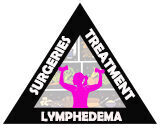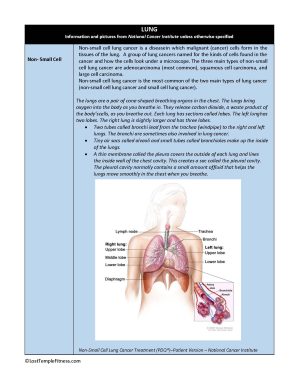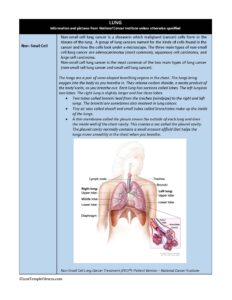Lung Cancer
Your Body is Your Temple
Research, Resources & Education
Table of Contents
Lung cancer is a highly complex and potentially life-threatening disease that requires immediate attention if it is to be treated effectively. It arises when cells in the lungs experience uncontrolled growth and division, leading to the development of malignant tumors. These tumors can spread to other parts of the body if they are not detected and treated early on. There are two main types of lung cancer: small-cell, which accounts for roughly 1 in 5 cases, and non-small-cell, which is the most common type and accounts for roughly 80-85% of cases.
Information and pictures from National Cancer Institute unless otherwise specified
Lung Anatomy

The lungs are a pair of cone-shaped breathing organs in the chest. The lungs bring oxygen into the body as you breathe in.
- They release carbon dioxide, a waste product of the body’s cells, as you breathe out.
- Each lung has sections called lobes.
- The left lung has two lobes.
- The right lung is slightly larger and has three lobes.
- Two tubes called bronchi lead from the trachea (windpipe) to the right and left lungs.
- The bronchi are sometimes also involved in lung cancer.
- Tiny air sacs called alveoli and small tubes called bronchioles make up the inside of the lungs.
- A thin membrane called the pleura covers the outside of each lung and lines the inside wall of the chest cavity.
- This creates a sac called the pleural cavity.
- The pleural cavity normally contains a small amount of fluid that helps the lungs move smoothly in the chest when you breathe.
Lung Cancer Videos
YouTube Videos that help explain types of Lung Cancer.
Disclaimer:
This is for research only and Lost Temple Fitness & Cancer does not endorse any video presented on this website.
It is advised that you ALWAYS CHECK WITH YOUR PHYSICIAN for a proper diagnosis and treatment plan.
Non-Small Cell Lung Cancer
Non-small cell lung cancer is a disease in which malignant (cancer) cells form in the tissues of the lung.
- A group of lung cancers named for the kinds of cells found in the cancer and how the cells look under a microscope.
- The three main types of non-small cell lung cancer are adenocarcinoma (most common), squamous cell carcinoma, and large cell carcinoma.
- Non-small cell lung cancer is the most common of the two main types of lung cancer (non-small cell lung cancer and small cell lung cancer).
- Each type of non-small cell lung cancer has different kinds of cancer cells.
- The cancer cells of each type grow and spread in different ways.
- The types of non-small cell lung cancer are named for the kinds of cells found in the cancer and how the cells look under a microscope:
- Squamous cell carcinoma: Cancer that begins in squamous cells, which are thin, flat cells that look like fish scales.
- This is also called epidermoid carcinoma.
- Large cell carcinoma: Cancer that may begin in several types of large cells.
- Adenocarcinoma: Cancer that begins in the cells that line the alveoli and make substances such as mucus.
- Other less common types of non-small cell lung cancer are: pleomorphic, carcinoid tumor, salivary gland carcinoma, and unclassified carcinoma.
- Squamous cell carcinoma: Cancer that begins in squamous cells, which are thin, flat cells that look like fish scales.
Non-Small Cell Treatments
Also see Treatments
Monoclonal antibodies – Monoclonal antibodies are immune system proteins made in the laboratory to treat many diseases, including cancer.
- As a cancer treatment, these antibodies can attach to a specific target on cancer cells or other cells that may help cancer cells grow.
- The antibodies are able to then kill the cancer cells, block their growth, or keep them from spreading.
- Monoclonal antibodies are given by infusion.
- They may be used alone or to carry drugs, toxins, or radioactive material directly to cancer cells.
Tyrosine kinase inhibitors – Tyrosine kinase inhibitors are small-molecule drugs that go through the cell membrane and work inside cancer cells to block signals that cancer cells need to grow and divide.
- Some tyrosine kinase inhibitors also have angiogenesis inhibitor effects.
Mammalian target of rapamycin inhibitors block a protein called mTOR, which may keep cancer cells from growing and prevent the growth of new blood vessels that tumors need to grow.
- Everolimus is a type of mTOR inhibitor.
Laser therapy is a cancer treatment that uses a laser beam (a narrow beam of intense light) to kill cancer cells.
Photodynamic therapy (PDT) is a cancer treatment that uses a drug and a certain type of laser light to kill cancer cells.
- A drug that is not active until it is exposed to light is injected into a vein.
- The drug collects more in cancer cells than in normal cells.
- Fiberoptic tubes are then used to carry the laser light to the cancer cells, where the drug becomes active and kills the cells.
- Photodynamic therapy causes little damage to healthy tissue.
- It is used mainly to treat tumors on or just under the skin or in the lining of internal organs.
- When the tumor is in the airways, PDT is given directly to the tumor through an endoscope.
Cryosurgery is a treatment that uses an instrument to freeze and destroy abnormal tissue, such as carcinoma in situ.
- This type of treatment is also called cryotherapy.
- For tumors in the airways, cryosurgery is done through an endoscope.
Electrocautery is a treatment that uses a probe or needle heated by an electric current to destroy abnormal tissue.
- For tumors in the airways, electrocautery is done through an endoscope.
Watchful waiting is closely monitoring a patient’s condition without giving any treatment until signs or symptoms appear or change.
- This may be done in certain rare cases of non-small cell lung cancer.
Radiation therapy
Chemotherapy
Immunotherapy
New types of treatment are being tested in clinical trials.
- Chemoprevention
- Radiosensitizers
- New combinations
Surgeries
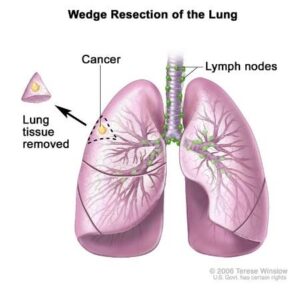

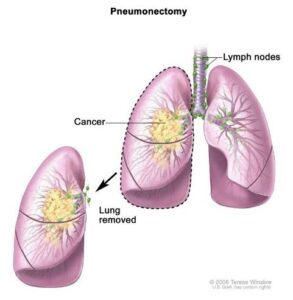
Wedge resection: Surgery to remove a tumor and some of the normal tissue around it.
- When a slightly larger amount of tissue is taken, it is called a segmental resection.
Lobectomy: Surgery to remove a whole lobe (section) of the lung.
Pneumonectomy: Surgery to remove one whole lung.
Sleeve resection: Surgery to remove part of the bronchus.
Small Cell Lung Cancer
Small cell lung cancer is a disease in which malignant (cancer) cells form in the tissues of the lung.
- An aggressive (fast-growing) cancer that forms in tissues of the lung and can spread to other parts of the body.
- The cancer cells look small and oval-shaped when looked at under a microscope.
There are two main types of small cell lung cancer.
- These two types include many different types of cells.
- The cancer cells of each type grow and spread in different ways.
- types of small cell lung cancer are named for the kinds of cells found in the cancer and how the cells look when viewed under a microscope:
- Small cell carcinoma (oat cell cancer).
- Combined small cell carcinoma.
The following stages are used for small cell lung cancer:
- Limited-Stage Small Cell Lung Cancer In limited-stage, cancer is in the lung where it started and may have spread to the area between the lungs or to the lymph nodes above the collarbone.
- Extensive-Stage Small Cell Lung Cancer In extensive-stage, cancer has spread beyond the lung or the area between the lungs or the lymph nodes above the collarbone to other places in the body.
- Small cell lung cancer can recur (come back) after it has been treated.
The cancer may come back in the chest, central nervous system, or in other parts of the body.
Small Cell Treatments
Also see Treatments
- Surgery may be used if the cancer is found in one lung and in nearby lymph nodes only.
- Because this type of lung cancer is usually found in both lungs, surgery alone is not often used.
- During surgery, the doctor will also remove lymph nodes to find out if they have cancer in them.
- Sometimes, surgery may be used to remove a sample of lung tissue to find out the exact type of lung cancer.
After the doctor removes all the cancer that can be seen at the time of the surgery, some patients may be given chemotherapy or radiation therapy after surgery to kill any cancer cells that are left.
- Treatment given after the surgery, to lower the risk that the cancer will come back, is called adjuvant therapy (see Chemotherapy under Treatments)
An endoscope is a thin, tube-like instrument used to look at tissues inside the body.
- An endoscope has a light and a lens for viewing and may be used to place a stent in a body structure to keep the structure open.
- An endoscopic stent can be used to open an airway blocked by abnormal tissue.
Chemotherapy
Radiation therapy
Targeted therapy
Laser therapy
Immunotherapy
Possible Side Effects, Recommendations and Risk Factors
Possible Side Effects and Recommendations
Possible Side Effects
- May need to be on oxygen
- Surgery: Side effects are very specific to particular surgery done.
Recommendations
- Improve your posture. Work on keeping your shoulders and chin back and opening your body to encourage deep breathing.
- Purse lip breathing and diaphragmatic breathing techniques.
- Do not apply pressure to chest lying on your stomach or against equipment
- Progress to pulmonary rehab
Risk Factors
- Smoking cigarettes, pipes, or cigars, now or in the past.
- This is the most important risk factor for lung cancer.
- The earlier in life a person starts smoking, the more often a person smokes, and the more years a person smokes, the greater the risk of lung cancer.
- Being exposed to secondhand smoke.
- Being exposed to asbestos, arsenic, chromium, beryllium, nickel, soot, or tar in the workplace.
- Being exposed to radiation from any of the following:
- Radiation therapy to the breast or chest.
- Radon in the home or workplace.
- Imaging tests such as CT scans.
- Atomic bomb radiation.
- Living where there is air pollution.
- Having a family history of lung cancer.
- Being infected with the human immunodeficiency virus (HIV).
- Taking beta carotene supplements and being a heavy smoker.
- Older age is the main risk factor for most cancers. The chance of getting cancer increases as you get older.
- When smoking is combined with other risk factors, the risk of lung cancer is increased.
Disclaimer: The information in this book/website is for educational purposes only and has been obtained through research, publications and personal experience, and shall not be liable for incorrect information. Any mentioned publications or websites does not imply endorsement. As this industry is ever changing, I urge readers to confirm the information contained in this book/website. The author will not be liable for any injuries sustained from practicing techniques taught or for any typographical errors or omissions.
It is advised that you always check with your medical doctor or physical therapist before starting an exercise program or change in diet.
|
Information and pictures from National Cancer Institute unless otherwise specified |
